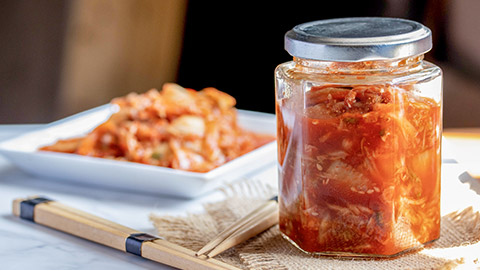As people discover new cuisines through travel, migration, exposure on media etc., new ingredients become fashionable and in-demand. Over the decades “new” ingredients have been discovered, gone mainstream and either stuck around or quietly disappeared.
For example, sun-dried tomatoes have been made for centuries in Mediterranean countries like Italy as a way of preserving the summer harvest for year-round use. As a result of the popularity of the “Mediterranean diet” in the 1980s, sundried tomatoes were suddenly fashionable elsewhere; the US, UK, Australia, New Zealand and many other countries went crazy for the powerfully-flavoured preserved tomatoes.
They quickly became a feature on almost every menu, turned into a bagel flavour, on top of pizzas, in salads, on antipasto platters, as a pasta dressing, to the point where sometime in the 1990s they suddenly became “unfashionable” and many chefs stopped using them. The influential food writer Ruth Reichl said “…people got tired of them. We were discovering all sorts of other ingredients, and sun-dried tomatoes just didn’t have that same kind of cachet”. Chef PJ Calapa was recently encouraged by his sous-chef to rename the ingredient “tomato conserva” on his menu to be able to use it!
(Krishna, 2018)
This example shows the influence of media and public perception on use of new ingredients. However, just because an ingredient is no longer seen as “fashionable” does not necessarily make it a “bad” ingredient. Clearly, food businesses need to be aware of what ingredients are available, and as new cuisines are popularised, new ingredients will also become popular.
Exercise 19
Find out which new ingredients are currently popular with chefs, or might soon be seen on menus. Where do they come from? Why have they become popular? How are they used in menus? (You should discuss at minimum of 5 new ingredients.)
Self-Directed Learning
Research, planning, writing and gathering examples for Task 2 (4).

The eating habits of customers have evolved and changed over the years, as a result of factors we have already examined in previous deliveries. With food being such an important part of our lives – not only nutritionally, but culturally and socially too – keeping up with ever-changing trends in food is important for a food business. The ability to evolve dishes, introduce new menu items or adapt to suit a major dietary trend can be the key to remaining relevant and profitable.
Dietary eating habits for weight loss
Theories of healthy eating have been part of society for centuries: it is believed that in 1028 William the Conqueror went on a diet consisting of almost nothing but alcohol in order to lose weight, and there have been many different ideas of diets since then. (Wdowik, 2017). Some notable recent examples of popular diets include:
- The Atkins Diet – a low-carb, high fat and high protein diet.
- The South Beach Diet – another low-carb diet, less restrictive than Atkins.
- The Cabbage Soup Diet – a quick way to lose weight by eating cabbage soup exclusively. Not designed to be a long-term diet but a quick-fix.
- Keto Diet – currently very popular, very low-carb diet designed to keep the body in ketosis, where it is burning body fat for energy.
- Blood Type Diet – A fad diet in which people were restricted to certain foods by their blood type.
- The Fasting Diet – also known as the 5:2 diet (eat as normal for five days, then a restricted low-calorie intake for two days). Currently a popular diet with some other medical benefits claimed.
(A Short History of Fad Diets, n.d.)
(Saner, 2017)
Research these diets and other popular diets to find out more information.
Therapeutic Diets
Many diets are designed to promote weight loss or tap into a perceived health “trend”, but there are other diets which some people need to follow for medical reasons. These are known as “Therapeutic Diets” and are designed as part of treatment for some serious conditions.
Some of these diets include:
- Diets for people with food intolerances or allergies – e.g. dairy-free and gluten-free diets. Other common allergens include eggs, peanuts, soy and shellfish. Allergens must be taken very seriously as severe anaphylactic reactions can result in death. A restaurant owner in the UK was jailed for 6 years for using peanuts in a takeaway curry, despite the customer clearly declaring his nut allergy. The customer subsequently died. (The Guardian-b, 2017)
- Low-fat/low-cholesterol diet.
- Diabetic diets to control blood sugar levels.
- Low/No Sodium diet to treat high blood pressure, heart disease, kidney disease etc.
Plant-based Diet
Once considered a fad diet, veganism has surged in popularity in recent years. As an example, the Vegan Society claims that the number of vegans in Great Britain increased 400% in the five years to 2019, with 41% of British people either removing meat or reducing the quantity of meat consumed in 2020. It also claims the three countries where veganism is most popular are the UK, Australia and New Zealand.
(The Vegan Society, n.d.)
Exercise 20
Research the vegan diet and make notes on how the veganism trend impacts hospitality.
- Which foods are vegans not allowed to consume?
- What are the different reasons for people to follow a vegan diet?
- Find examples of plant-based innovations which are now mainstream – how does the trend for veganism affect the hospitality industry?
- How a food business should respond to dietary trends. What about allergies and intolerances?
Self-Directed Learning
Continue research, planning, writing and gathering examples for Task 2 (4).
Some other key eating habit trends to consider:
Locavore dining
A growing trend favouring locally-grown and produced food ingredients. Benefits include seasonality, supporting local economy, reduced transport costs (therefore environmental benefits), freshness of ingredients, building strong supplier relationships.

(Locavore, n.d.)
Street food and food trucks
Low-cost, casual, fast and simple, street food can introduce new flavours and is a good way for newcomers to get into the business. Street food is often mobile, meaning it can move to where people want it, and usually has a very limited menu, which means it can easily produce high volumes of good quality food. (D, 2021)

Artisan food
Compatible with the locavore trend, artisan food is food which has been made in a traditional way – small production, often hand-made or minimally mechanised, slow and natural production. Some key artisan products include breads (e.g. sourdough), charcuterie and cured meats, terrines and pâtés, cheese, fermented foods etc. These products are popular because they are seen as honest, traditional and support local producers.
(What Is Artisan Food | The School of Artisan Food - The School Of Artisan Foods, n.d.)

Slow-food movement
Another trend compatible with locavore and artisan food, the Slow Food Movement has been around since 1989 and has its aim to “prevent the disappearance of local food cultures and traditions, counteract the rise of fast life…” (About Us, 2017). It has developed into a global organisation, present in more than 160 countries and with millions of members.
Fermented and pickled food
Kimchi, kombucha, sauerkraut, miso, and kefir are just a few examples of fermented food ingredients which have become popular over the last few years. Even though they have been made for centuries, their health benefits have only recently been publicised in the mainstream media. Dr Michael Mosely, well-known for his appearances on TV to promote ways to improve health, explains that fermented foods contain a huge number of beneficial microbes, which promote good gut health. This is now seen as being very important to overall general health. (Fermenting Is the Food Trend You Need - for Your Gut’s Sake, 2017)

Exercise 21
Research three or four eating habit trends you would like to try over the coming year. Write brief notes about what they involve and why they appeal to you.
Self-Directed Learning
Familiarise yourself with Task 3 requirements (following section).
From your work on Task 2, research New Zealand examples showing the same Trends and Developments evident in this country. Gather material, ready to use in Task 3. Save links for referencing.
Task 3 Requirements
Task 3 builds on your research and learning from Task 2. You need to choose two topics you wrote about in task 2 and apply them to New Zealand. This means you should choose two from Internet/Social Media, Food Production, Restaurant Trends and Eating Habits which you found the most interesting, or most relevant to New Zealand and find examples of those factors here.
So, for example, if you wrote about the use of drone technology in managing farms in the USA, you should look for examples where similar technology is being used here in New Zealand. (Note: a very quick Google search on this topic came up with some good examples immediately – e.g. https://dronespraying.co.nz )
You only have around 300 words for this section, so remember to keep your ideas to the point, and as always, use plenty of images to help tell your story.
Don’t forget to use plenty of images or graphics to help you explain your point, and remember to reference your sources – using intext references and full APA reference list at the end.
Increased Restaurant Competition
Despite relatively low net-profit margins and food businesses constantly coming and going, the number of dining destinations is increasing. The USA has over 1 million hospitality outlets (one for every 332 people, (Maze, 2018)), and in 2017 New Zealand had over 17,000 (one for every 271 people, with Auckland accounting for nearly 40% of the dollars generated – source: Restaurant Association of New Zealand 2018 Hospitality Report).
How does competition affect food businesses?

From the 2018 report from the Restaurant Association of New Zealand there was an expectation that there would be growth for operators who “hone and deliver their product well, and for those that embrace changing consumer dining trends and developments in technology”. Keeping menus fresh and relevant to target market requirements is increasingly important, but there are other reasons customers choose a particular food business:
- Location
- Price
- Ambience
- Service
- Food and beverage offer
Point of difference
This is what distinguishes one business from another. There are many ways a food business can offer a point of difference. To remain competitive, every food business should ensure it is not only offering value for money nut also has a “point of difference” (or “unique selling proposition”) to market itself on. A simple way to look at this is to be the “best” at something – best location, best food, best service, best ambience, best price etc. It is not necessary to be the best at everything - being consistently good overall, but better than competitors in one area is often a strong marketing position to hold. Avoid the temptation to always be the cheapest – cheap food which is not also good food is not a good recipe for a successful business.
Covid-19
Since the publication of the 2018 Restaurant Association report, the industry (and the whole world) has undergone a huge disruption through the Covid-19 pandemic. In the USA more than 110,000 restaurants had closed permanently, or long-term, due to the pandemic. (bloomberg.com, 2020). For those operators who have survived it has become even more important to respond to customer requirements and adapt their business accordingly. The pandemic has seen fine dining restaurants like Manchester’s Mana resort to making takeaway gourmet burgers to stay afloat, others have created prepared meal kits of their dishes to deliver to customers’ homes (Hirst, 2021)
Growing Middle Class

(Cambridge Dictionary, 2021g)
(bbc.co.uk, 2013)
(brookings)
As you can see from these statistics, the proportion of the world’s population which is defined as “middle class” is set to increase dramatically over the next decade, and particularly so in countries with developing economies. The meaning of “middle class” is quite vague, but in essence it indicates a group of the population with a significant amount of disposable income – i.e. household income left after bills and spending on essentials have been paid and which can be spent as they choose.
Effect on food commodities
One area where this disposable income is likely to be spent is on food – more of it, better quality and safer. Where some ingredients were once eaten on special occasions only, or not even available at all, they are now available and attainable to many millions more people worldwide. (Euromonitor Research, 2017)
Unfortunately, many of these “luxury” ingredients such as beef, lamb and dairy products have a severe negative impact on the environment and climate change, and the increased demand leads to higher commodity prices globally. These higher prices are inevitably passed on to consumers and food businesses.
Effect on food businesses
With more disposable income more people are able to eat out. While this has an impact on every country experiencing a growing middle class, the effect on developing nations where the middle class is growing fastest is the most clear.
Exercise 22
Look in the Resource Folder in your class Team - your tutor has uploaded the 2018 and 2019 Restaurant Association Reports. Read them and make notes in your journal about food trends in New Zealand
Self-Directed Learning
In what other ways does the growing middle class affect the hospitality industry? (Think about what people do with spare money.)
China has seen a rapid increase in demand for American fast-food since KFC, McDonald’s and others first opened there in the late 1980s /early 1990s. KFC now has over 5,000 branches in China – more than in the USA. (Daxue Consulting, 2019).
It is not just fast food which has taken off in China – many high-end restaurants have also opened in the last 25 years to meet the increasing demand for Western food by an increasingly wealthy and knowledgeable population. (Min, 2017). China now boasts 42 Michelin-starred restaurants, the first having been awarded in 2017.
Ultraviolet by Paul Pairet, Shanghai
A “multi-sensory” restaurant in a secret location in Shanghai, this restaurant seats only 10 diners who are served a meal of 20 courses for around US$600 each, enhanced with lights, sounds and aromas. It has been awarded the maximum possible 3 Michelin stars. (UltraViolet, n.d.)
L’Atelier de Joel Robuchon, Shanghai
One of several restaurants worldwide opened by the legendary Joel Robuchon, this restaurant has 2 Michelin stars and serves refined French cuisine.
Opera Bombana, Beijing
Opened in 2013 by 3 Michelin-starred Italian chef Umberto Bombana, this is a modern restaurant serving refined Italian food. Their dishes have undergone “modernisation, and, where appropriate, localisation”
(Opera BOMBANA, n.d.)
Exercise 23
Find examples of how growing wealth in other developing nations is affecting the dining options and style of food served. Makes notes in your journal.
Self-Directed Learning
No SDL Fridays (4 hours per week)
